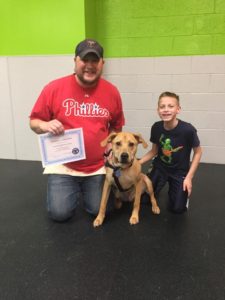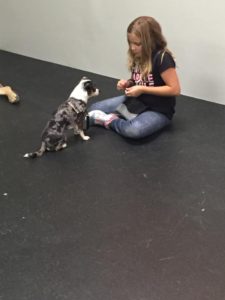As a dog trainer, the call I dread getting is the one that starts with “Our dog bit our child….”. When a dog bites a child, even if it isn’t a medically serious bite, the relationship between the dog and the family can be forever changed. Many times the family no longer trusts the dog after a bite. They either re-home him or the dog is banished to the crate or a far away room whenever children are around. Most, if not all, bites to children can be prevented. Basic supervision, educating kids on how to safely and respectfully interact with dogs, and by managing the children’s and dog’s environment can prevent bites. These simple tips can help make interactions between dogs and children safer.
Our 10 Tips for Dogs and Kids
- Don’t let your kids hugs dogs. I know this is a bummer for kids, but most dogs don’t like to be hugged, especially by children they do not know. When I work with families with dogs, I ask the kids “how long do mommy and
 daddy have a new friend before you give them a hug when they come over?” – the answer is usually something like “a really long time”. I suggest families use this same rule of thumb with dogs. Don’t hug a newly adopted dog, or even one you have had for a few weeks. The dog will tell you when it is ready to be snuggled. He will lean into you, curl up next to you, or try to sit with you. These are all signs that he wants your affection. When he does this, pet him on his back or sides, and let him lean into you rather than hug him.
daddy have a new friend before you give them a hug when they come over?” – the answer is usually something like “a really long time”. I suggest families use this same rule of thumb with dogs. Don’t hug a newly adopted dog, or even one you have had for a few weeks. The dog will tell you when it is ready to be snuggled. He will lean into you, curl up next to you, or try to sit with you. These are all signs that he wants your affection. When he does this, pet him on his back or sides, and let him lean into you rather than hug him. - Don’t leave children and dogs alone together. This one can be a bit trickier, but it is super-important to make this rule how you live with your dog. Some easy ways to do this is to teach your dog a “with me” command. When you, the supervising adult, needs to leave the room for a few minutes tell the dog “with me”. Pat your leg to get him to follow you. If you have trained this by rewarding the dog with treats, toys, or petting for following you, when you say “with me”, he will happily follow you out of the room and stay with you. If you can’t take the dog with you, teach him to love his crate, and he goes in the crate when you can’t be in the room to actively supervise the dog with the children.
- Teach kids how to approach a dog to see if she wants to be pet. Teach kids not to pet dogs on the top of the head. They also should not to reach for a strange dog or offer a hand for sniffing. Have your child pat his/her leg and then wait to see if the dog approaches. If the dog approaches, let him sniff your pant leg or shoes first. Then, if he stays there, pet on the back or side, not the face or head.
- Make sure your dog gets enough exercise. Tired dogs rest nicely in crates when kids are around. See last week’s post for ways to tire your dog out https://pepperspaws.com/tired-dog-good-dog/.
- Get to know your dog. Learn to read dog body language (check out this video for more info).Keep your dog’s annual vet check up. Dogs that are in pain or don’t feel well can be less than hospitable when children are around. Learn your dog – what does she do when she doesn’t feel well? What does he do when he is in pain? What does “normal” look like in your dog’s world? If you think your dog doesn’t feel well, let him rest in his crate, away from excited kids.
- Crate train your dog. If you need help with this, let us know.
- Let your dog eat in peace. Meal time is not a good time to pester, annoy, tease, or otherwise bother your dog. “Testing” your dog to see if you can pick up his bowl while he is eating is not a good way to teach him you are the boss. If you’d like other ways to teach your dog that you – the adult – being nearby at mealtime is a good thing, ask us.
- Have your kids help with training. Positive reinforcement training can be a great way for supervised dogs and
 children to bond. If you aren’t sure how to get started with this, give us a call – classes and private in home lessons are a great way to get started on this.
children to bond. If you aren’t sure how to get started with this, give us a call – classes and private in home lessons are a great way to get started on this. - Don’t allow kids or adults to rough house with the dog. I know, I know, I’m no fun. Trust me when I tell you rough housing is NOT a good way to exercise your dog. I have received more than one call about wrestling matches that ended with bites. If you want your dog to think you are a rock star, train him to roll over, retrieve toys, walk nicely on a leash so he gets lots of walks – he will love this way more than wrestling with you.
- When you think you need help, because you’ve seen your dog do something around your children that scares you, get help right then. Don’t wait until something bad happens and someone gets scared or hurt (to a child, getting scared can be just as bad as being bitten). If you wait, it might be too late. Help with dogs and kids is available!
Need help teaching your kids how to greet dogs, pet dogs, or read body language? We have a special program for families with dogs. Click here for more information: https://pepperspaws.com/about-peppers-paws-llc-dog-training/kids-dogs-training/
Pepper’s Paws, LLC provides in home dog training in Rehoboth Beach DE and surrounding communities. We also offer Zoom dog training lessons for people who do not live in our private lessons service area.
Head trainer Deb Murray, CBCC-KA, CPDT-KA is certified by the Certification Council of Professional Dog Trainers, an AKC Evaluator, a Doggone Safe “Be a Tree” Presenter, and a Distinguished Graduate and Mentor Trainer for the Catch Canine Academy.